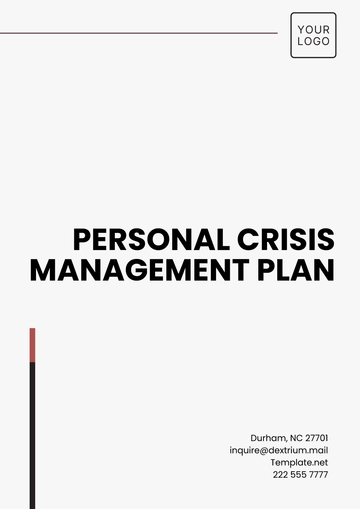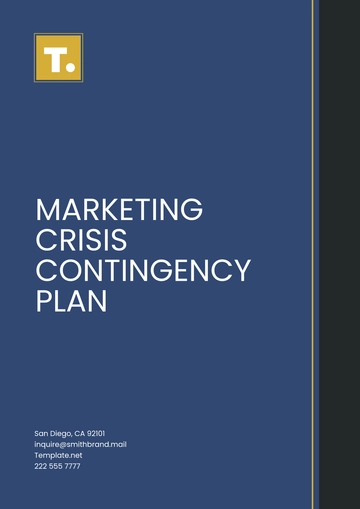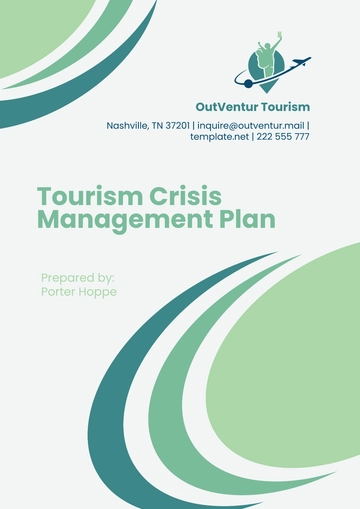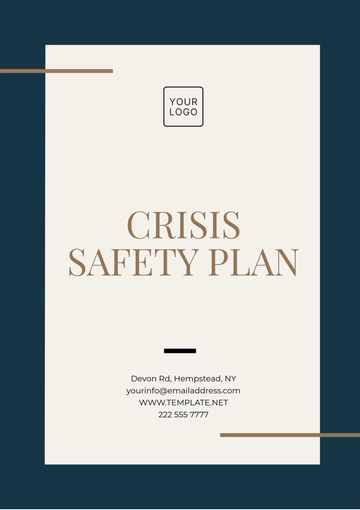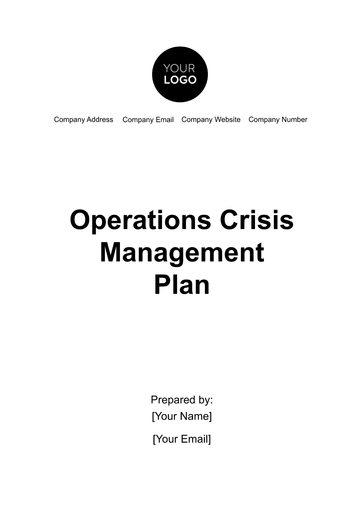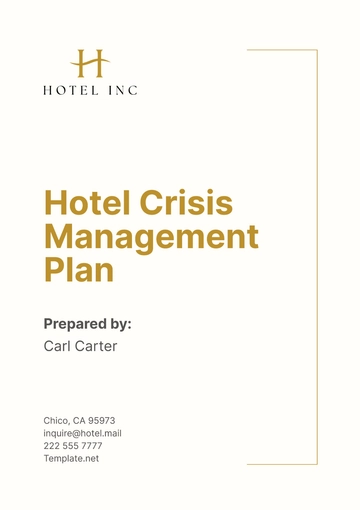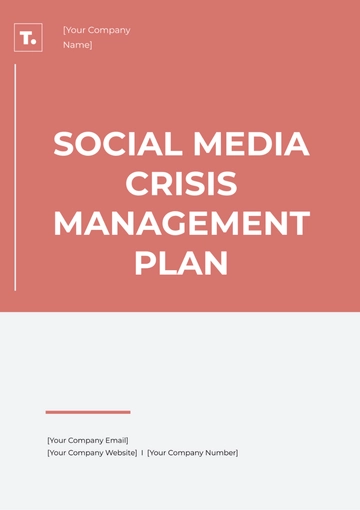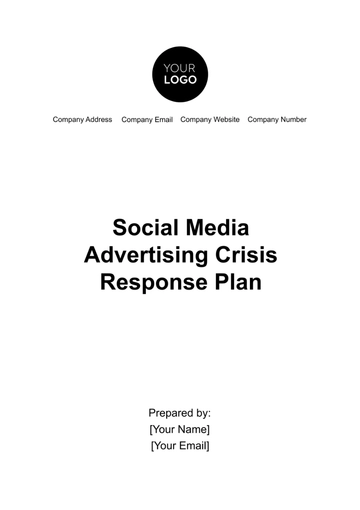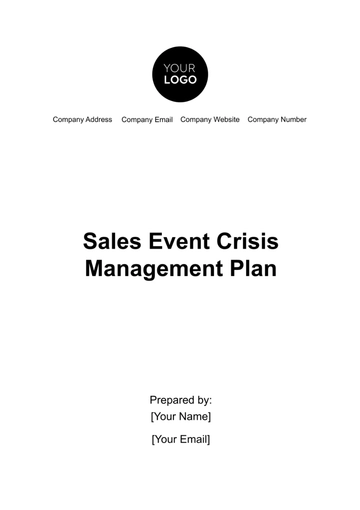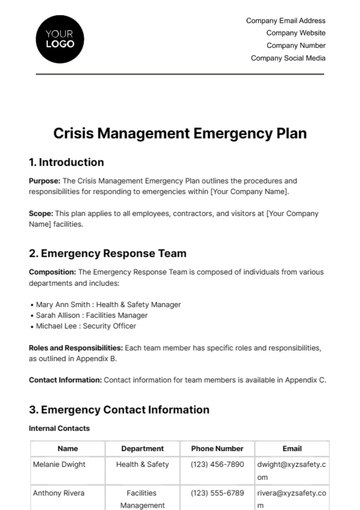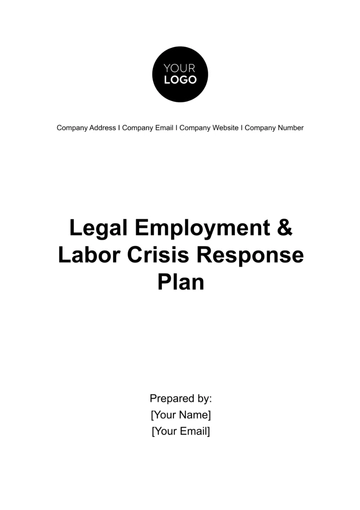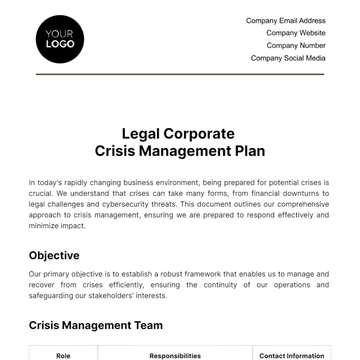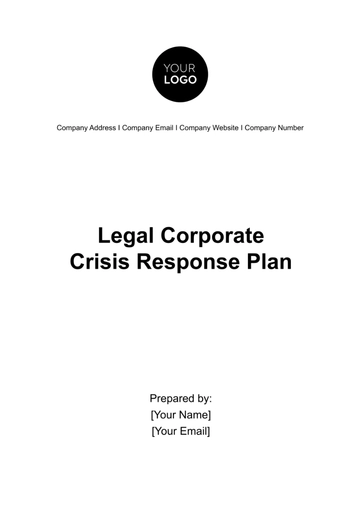Free Legal Corporate Crisis Response Plan
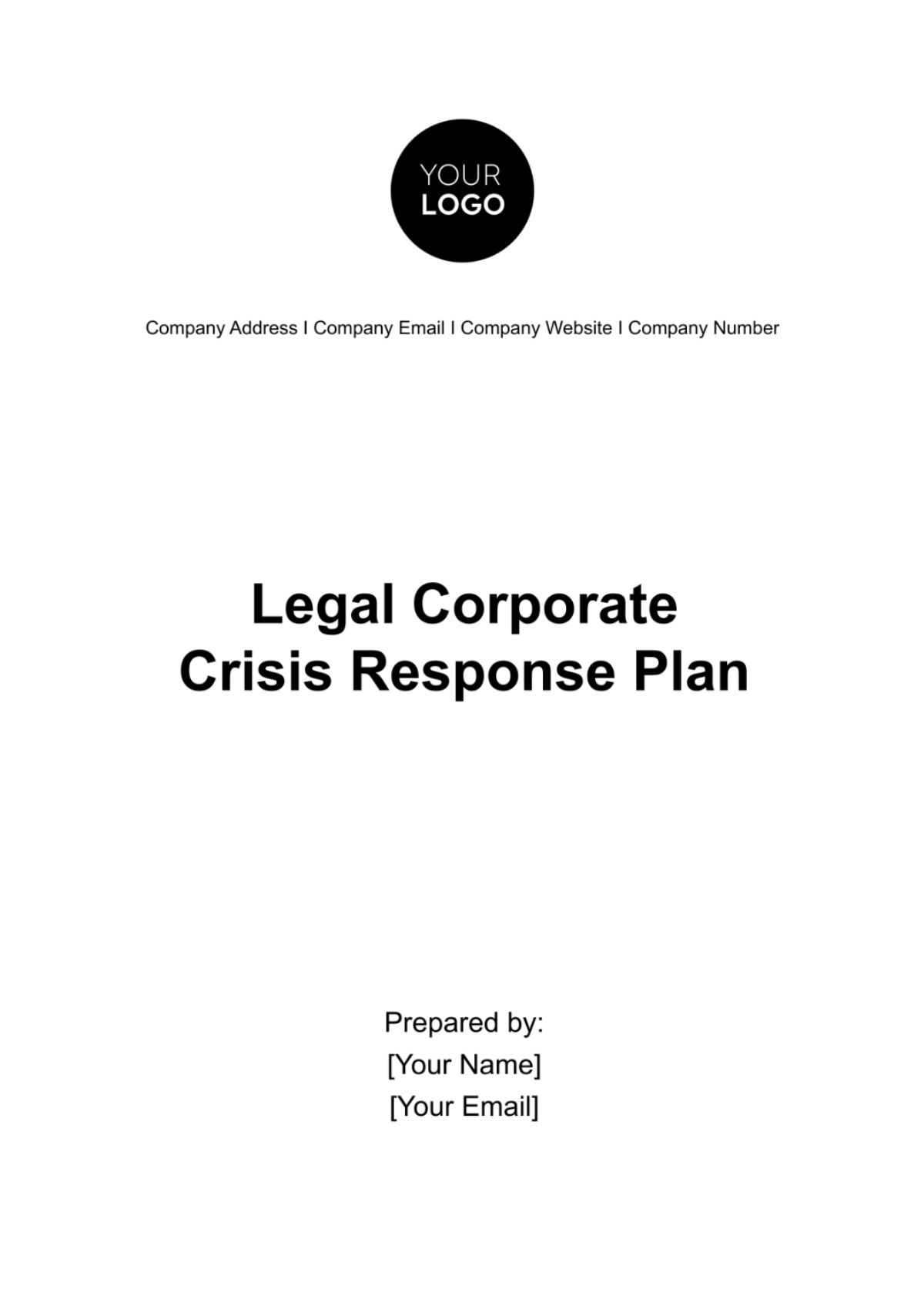
I. Introduction
The purpose of this Legal Corporate Crisis Response Plan is to outline a structured and effective approach for managing and mitigating legal crises that may arise. Our objective is to ensure that we are prepared to respond promptly and efficiently to protect our reputation, stakeholders, and financial stability. This plan establishes the procedures and responsibilities necessary to navigate legal challenges while maintaining our operational integrity and compliance with applicable laws and regulations.
This plan covers a wide range of potential legal crises, including but not limited to regulatory investigations, litigation, data breaches, compliance violations, and any other legal matters that could significantly impact our operations or public image. It is designed to provide a comprehensive response framework that can be adapted to the specific nature and requirements of the crisis at hand, ensuring that all legal, communicational, and operational aspects are addressed.
II. Crisis Management Team
The successful management of a legal crisis requires the coordinated efforts of our crisis management team, which comprises senior executives and key department heads. This team is responsible for the overall direction and execution of the crisis response, including decision-making, internal and external communications, and coordination with legal counsel. The table below outlines the primary responsibilities and the decision-making hierarchy within the crisis management team:
Member | Responsibilities | Hierarchy |
CEO | Overall crisis leadership, final decision authority, spokesperson for high-level communications. | 1 |
CLO | Legal assessment and strategy, liaison with external counsel, legal compliance, regulatory communications. | 2 |
COO | Operational continuity, resource allocation, internal coordination. | 3 |
CFO | Financial impact analysis, budgeting for crisis response, investor relations. | 4 |
PR Head | Media relations, public statements, press releases, social media management. | 5 |
HR Head | Employee communications, welfare, and support during the crisis. | 6 |
This hierarchical structure ensures that decisions are made efficiently and are communicated effectively across our organization, with the CEO having the ultimate authority over final decisions related to the crisis management process.
III. Identification of Potential Crises
A. Types of Crises
Understanding the types of legal crises that could potentially affect us is crucial for effective preparedness and response. Below are key legal crises, along with descriptions:
Regulatory Investigations: These involve formal inquiries by governmental or regulatory bodies into our practices, potentially due to compliance failures or allegations of misconduct. Such investigations can lead to fines, sanctions, or operational restrictions.
Litigation: Legal actions brought against us by individuals, organizations, or governmental entities. Litigation can range from employment disputes to contractual disagreements, posing significant financial and reputational risks.
Data Breaches: Unauthorized access to or disclosure of sensitive data, which can lead to legal action from affected parties or regulatory penalties. Data breaches undermine trust and may have severe implications for privacy compliance.
B. Early Warning Signs
Recognizing early warning signs is essential for preempting or mitigating legal crises. Early identification allows for quicker response and potentially lessens the impact. Below is a table of common warning signs and their implications:
Warning Sign | Implication |
Unusual regulatory inquiries | May indicate forthcoming investigations or audits. |
Increased litigation against peers | Suggests an industry-wide issue that could soon involve us. |
Reports of data system vulnerabilities | Potential precursors to data breaches or cybersecurity incidents. |
IV. Response Procedures
A. Initial Assessment
Upon identifying a potential legal crisis, an initial assessment is crucial to understand its scope, impact, and urgency. Guidelines for this assessment include:
Determine the immediacy of the threat to prioritize actions.
Assess the potential legal and financial impact to allocate resources appropriately.
Identify key stakeholders affected by the crisis to guide communication strategies.
B. Notification Process
Effective and timely notification within our organization is critical. Guidelines for the notification process include:
Activate the crisis management team immediately upon identification of a potential legal crisis.
Inform relevant department heads to ensure operational readiness and support.
Establish a central point of communication for coordinating responses and sharing information.
C. External Communication
Managing external communications is vital to maintaining our reputation and stakeholder trust. Guidelines for external communication include:
Prepare official statements that are clear, concise, and factual.
Designate official spokespersons to ensure consistent messaging.
Monitor media and social media to address misinformation and gauge public sentiment.
D. Documentation and Evidence Preservation
Preserving documentation and evidence is critical for legal defense and compliance. Guidelines include:
Secure relevant documents and electronic data immediately to prevent loss or tampering.
Maintain a detailed log of all actions taken in response to the crisis, including communications.
Coordinate with IT and legal departments to ensure proper handling and storage of sensitive information.
V. Legal Strategies
A. Legal Assessment
A comprehensive legal assessment is the cornerstone of our response to any legal crisis. This assessment evaluates the legal implications, risks, and potential outcomes of the situation. Guidelines for conducting a legal assessment include:
Review all relevant facts and documents to understand the context and specifics of the crisis.
Analyze applicable laws and regulations to assess compliance issues and legal liabilities.
Consult with internal legal teams to leverage their expertise and insights.
B. Strategy Development
Developing a robust legal strategy is essential for navigating crises effectively. This strategy may involve litigation, negotiation, or regulatory compliance, depending on the nature of the crisis.
Litigation: Pursuing or defending against legal action may be necessary to protect our interests. Litigation requires thorough preparation, a strong factual and legal basis, and consideration of the potential impact on our reputation and finances.
Negotiation: In many cases, negotiating a settlement or resolution can be more advantageous than litigation. It can provide a quicker, less costly, and more discreet way to resolve disputes.
Regulatory Compliance: Ensuring compliance with regulatory requirements is critical. Proactively addressing compliance issues can mitigate penalties and demonstrate our commitment to lawful conduct.
C. External Legal Support
Engaging external legal counsel provides specialized expertise and an objective perspective. Guidelines for when and how to engage external legal counsel include:
Identify situations requiring specialized legal expertise not available in-house.
Select counsel with specific experience in the relevant area of law and industry.
Establish clear communication and reporting protocols to ensure alignment and efficient collaboration.
VI. Training and Drills
Regular training and drills are vital to ensuring that our team is prepared to implement the crisis response plan effectively. These exercises help familiarize the team with their roles and the procedures they need to follow during a crisis.
Training Module | Frequency | Duration |
Crisis Management Team Training | Bi-annually | 4 hours |
Legal Assessment Procedures | Annually | 2 hours |
Documentation and Evidence Handling | Annually | 3 hours |
Communication During a Crisis | Bi-annually | 3 hours |
External Legal Coordination | Annually | 2 hours |
VII. Communication Plan
A. Internal Communication
Effective internal communication is crucial for ensuring that all team members are informed, prepared, and aligned during a legal crisis. We will implement a structured communication plan that includes regular updates, briefings, and access to a central information repository. This plan ensures that all employees understand their roles and responsibilities, the current status of the crisis, and how it affects them. Clear, concise, and consistent messaging will help maintain morale and prevent the spread of rumors within the organization.
B. Public Relations
Our public relations strategy is designed to manage and mitigate the impact of the legal crisis on our public image. This includes preparing official statements, press releases, and managing social media communications. The goal is to present a unified, transparent, and positive image to the public, emphasizing our commitment to resolving the issue promptly and responsibly. We will closely monitor media coverage and public sentiment to adjust our strategy as needed, ensuring that our messaging is effective and aligns with our organizational values.
C. Stakeholder Engagement
Engaging with stakeholders is an integral part of our crisis response plan. This includes communicating with investors, customers, partners, and regulatory bodies to maintain their trust and confidence in our ability to manage the crisis. Our approach involves transparently sharing relevant information, providing regular updates on our progress, and demonstrating our commitment to resolving the issue in accordance with our values and legal obligations. By actively managing these relationships, we aim to minimize negative impacts and support our long-term recovery and success.
VIII. Review and Update
Continuous improvement is key to the effectiveness of our Legal Corporate Crisis Response Plan. Following the resolution of a crisis, we will conduct a comprehensive review of our response, including what worked well and areas for improvement. This review will involve input from all levels of the organization and external advisors as appropriate. Based on the findings, we will update the plan to incorporate new strategies, procedures, and training needs. The plan will be reviewed and updated at least annually, or more frequently as needed, to reflect changes in our business environment, legal obligations, and best practices in crisis management. This ongoing process ensures that our plan remains robust, relevant, and ready to activate when needed.
- 100% Customizable, free editor
- Access 1 Million+ Templates, photo’s & graphics
- Download or share as a template
- Click and replace photos, graphics, text, backgrounds
- Resize, crop, AI write & more
- Access advanced editor
The Legal Corporate Crisis Response Plan Template from Template.net is an indispensable tool for preparing organizations to handle legal crises effectively. This template is fully editable and customizable, allowing for precise adaptation to any corporate scenario. Also editable in our AI Editor tool, it provides a strategic blueprint for rapid, coordinated action in critical situations, ensuring legal and operational resilience.
You may also like
- Finance Plan
- Construction Plan
- Sales Plan
- Development Plan
- Career Plan
- Budget Plan
- HR Plan
- Education Plan
- Transition Plan
- Work Plan
- Training Plan
- Communication Plan
- Operation Plan
- Health And Safety Plan
- Strategy Plan
- Professional Development Plan
- Advertising Plan
- Risk Management Plan
- Restaurant Plan
- School Plan
- Nursing Home Patient Care Plan
- Nursing Care Plan
- Plan Event
- Startup Plan
- Social Media Plan
- Staffing Plan
- Annual Plan
- Content Plan
- Payment Plan
- Implementation Plan
- Hotel Plan
- Workout Plan
- Accounting Plan
- Campaign Plan
- Essay Plan
- 30 60 90 Day Plan
- Research Plan
- Recruitment Plan
- 90 Day Plan
- Quarterly Plan
- Emergency Plan
- 5 Year Plan
- Gym Plan
- Personal Plan
- IT and Software Plan
- Treatment Plan
- Real Estate Plan
- Law Firm Plan
- Healthcare Plan
- Improvement Plan
- Media Plan
- 5 Year Business Plan
- Learning Plan
- Marketing Campaign Plan
- Travel Agency Plan
- Cleaning Services Plan
- Interior Design Plan
- Performance Plan
- PR Plan
- Birth Plan
- Life Plan
- SEO Plan
- Disaster Recovery Plan
- Continuity Plan
- Launch Plan
- Legal Plan
- Behavior Plan
- Performance Improvement Plan
- Salon Plan
- Security Plan
- Security Management Plan
- Employee Development Plan
- Quality Plan
- Service Improvement Plan
- Growth Plan
- Incident Response Plan
- Basketball Plan
- Emergency Action Plan
- Product Launch Plan
- Spa Plan
- Employee Training Plan
- Data Analysis Plan
- Employee Action Plan
- Territory Plan
- Audit Plan
- Classroom Plan
- Activity Plan
- Parenting Plan
- Care Plan
- Project Execution Plan
- Exercise Plan
- Internship Plan
- Software Development Plan
- Continuous Improvement Plan
- Leave Plan
- 90 Day Sales Plan
- Advertising Agency Plan
- Employee Transition Plan
- Smart Action Plan
- Workplace Safety Plan
- Behavior Change Plan
- Contingency Plan
- Continuity of Operations Plan
- Health Plan
- Quality Control Plan
- Self Plan
- Sports Development Plan
- Change Management Plan
- Ecommerce Plan
- Personal Financial Plan
- Process Improvement Plan
- 30-60-90 Day Sales Plan
- Crisis Management Plan
- Engagement Plan
- Execution Plan
- Pandemic Plan
- Quality Assurance Plan
- Service Continuity Plan
- Agile Project Plan
- Fundraising Plan
- Job Transition Plan
- Asset Maintenance Plan
- Maintenance Plan
- Software Test Plan
- Staff Training and Development Plan
- 3 Year Plan
- Brand Activation Plan
- Release Plan
- Resource Plan
- Risk Mitigation Plan
- Teacher Plan
- 30 60 90 Day Plan for New Manager
- Food Safety Plan
- Food Truck Plan
- Hiring Plan
- Quality Management Plan
- Wellness Plan
- Behavior Intervention Plan
- Bonus Plan
- Investment Plan
- Maternity Leave Plan
- Pandemic Response Plan
- Succession Planning
- Coaching Plan
- Configuration Management Plan
- Remote Work Plan
- Self Care Plan
- Teaching Plan
- 100-Day Plan
- HACCP Plan
- Student Plan
- Sustainability Plan
- 30 60 90 Day Plan for Interview
- Access Plan
- Site Specific Safety Plan
